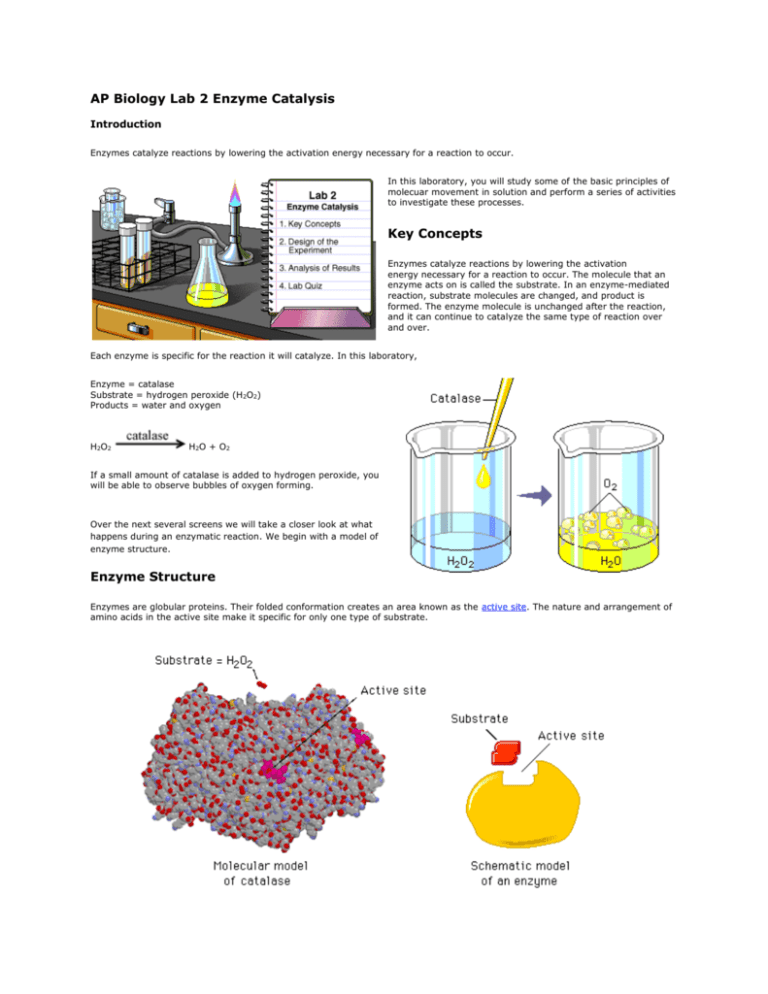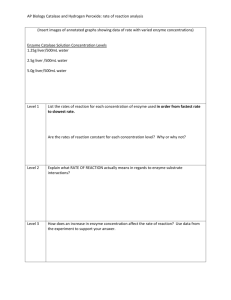AP Biology: Enzyme Catalysis Lab - Catalase & H2O2
advertisement

AP Biology Lab 2 Enzyme Catalysis Introduction Enzymes catalyze reactions by lowering the activation energy necessary for a reaction to occur. In this laboratory, you will study some of the basic principles of molecuar movement in solution and perform a series of activities to investigate these processes. Key Concepts Enzymes catalyze reactions by lowering the activation energy necessary for a reaction to occur. The molecule that an enzyme acts on is called the substrate. In an enzyme-mediated reaction, substrate molecules are changed, and product is formed. The enzyme molecule is unchanged after the reaction, and it can continue to catalyze the same type of reaction over and over. Each enzyme is specific for the reaction it will catalyze. In this laboratory, Enzyme = catalase Substrate = hydrogen peroxide (H2O2) Products = water and oxygen H2O2 H2O + O2 If a small amount of catalase is added to hydrogen peroxide, you will be able to observe bubbles of oxygen forming. Over the next several screens we will take a closer look at what happens during an enzymatic reaction. We begin with a model of enzyme structure. Enzyme Structure Enzymes are globular proteins. Their folded conformation creates an area known as the active site. The nature and arrangement of amino acids in the active site make it specific for only one type of substrate. Binding Specificity Even when different substrate molecules are present, only those that have the specific shape complementary to the active site are able to bind with the enzyme's active site. Induced Fit When an enzyme binds to the appropriate substrate, subtle changes in the active site occur. This alteration of the active site is known as an induced fit. Induced fit enhances catalysis, as the enzyme converts substrate to product. Release of the products restores the enzyme to its original form. The enzyme can repeat this reaction over and over, as long as substrate molecules are present. Design of the Experiment In this experiment, you will investigate the rate at which the enzyme catalase converts substrate to product. You will allow catalase to react with hydrogen peroxide for varying amounts of time and then stop the reactions by adding H 2SO4. To determine the amount of hydrogen peroxide that remains after the reaction, you will do a titration with KMnO 4. In such a titration, you slowly add a chemical (KMnO4) that will cause a color change until a target color is achieved. The following illustration shows you an overview of the procedure. Doing the Titration To determine how much hydrogen peroxide (substrate) has been broken down by catalase at varying times, you measure the amount of peroxide remaining in each flask. You slowly add KMnO4, which is purple, to the flask. The peroxide in the flask causes the KMnO4 to lose color when the solution is mixed thoroughly. When all the peroxide has reacted with KMnO4, any additional KMnO4 will remain light brown or pinkish even after you swirl the mixture. This is the endpoint. Record the amount of KMnO4 you have used. (The more KMnO4 you use, the more peroxide is in the flask.) Lab Hints 1. Be sure to titrate only 5 ml of the sample at a time. This way, if you exceed the endpoint or have an error in titration, you will have sufficient sample to repeat the titration. 2. Since you will be comparing amounts of H2O2 remaining in the sample after different reaction times, be sure all your samples are the same size (5 ml). 3. Place the solution to be titrated over a piece of white background paper so you can see the color changes easily. 4. Swirl (do not shake) the flask after every few drops to mix well. 5. For each assay, be sure to stop the titration at the same color. Reading a Burette Assume that the burette is filled to the point indicated in the figure at the left. You would record the initial point as 3.30 ml; the ending point would be 3.90 ml. Therefore, the titration would have required 0.60 ml. Remember that you should read the number that is at the bottom of the meniscus. Analysis of Results Enzyme Action Over Time We can calculate the rate of a reaction by measuring, over time, either the disappearance of substrate (as in our catalase example) or the appearance of product (as in the above graph). For example, on the graph above, what is the rate, in moles/second, over the interval from 0 to 10 seconds? so for this example, the rate would be







